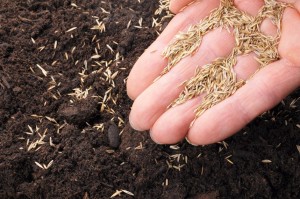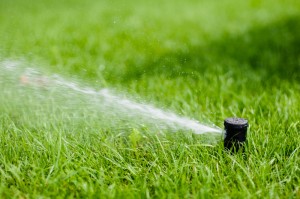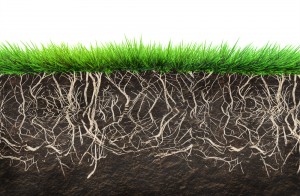
Before it Germinates
The first few weeks after seeding are the most crucial. You need to keep the seed moist. Moist doesn’t mean water-logged. It means moist. Think of it this way. You don’t need a whole lot of water on the seed to make it moist. However, that means it won’t take long to dry out. The best way to achieve this is to water the seeded areas for approximately 15-25 minutes, about 2-3 times per day. This will keep that top 1/2″-1″ of soil moist. Keeping the seed in that state will promote the seeds to germinate. If this process gets interrupted and you forget to water for several days, some seed will lose it’s viability to germinate, which means less grass growing in these areas. So to sum it up, “Less Water/Lots of Times”.
After it Germinates
If you’ve successfully made your grass seeds germinate, now is the time for them to mature from seedlings into mature grass plants. This means growing a healthy root system. This means the soil needs to be moist (again not water-logged), not a seed. The basic concept is to create a moisture-rich environment 2″-3″ below the soil so the roots will grow to areas with water present. If you only water to make 1″ of soil moist, guess what? You’ll only get 1″ of root mass because there’s nothing for a root to get below that. The best way to achieve this is to water the seeded areas for approximately 45-60 minutes, about 2-3 times per week. That will encourage roots to plunge deeper into the soil. So to sum it up, “Lots of Water/Less Times”.
How to Water
There are all sorts of kinds of irrigation options. The ones that work the best are adjustable solutions that work best in the space being watered. Obviously a professionally-installed irrigation system would be the best option but it’s also the most expensive solution, and it’s permanent. Many people just want a short-term solution to help them get the lawn going for the first couple months. Here are a couple sprinkler types to consider. Please notice standing there with a hose isn’t mentioned. That’s because it’s very deceiving and actually simulates a quick, hard rain which again is not what you’re going for. Here are a few types of sprinklers you will find for purchase at your local home and garden center.
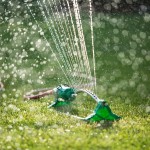
Oscillating Sprinklers
These sprinklers are great for treating a narrow, long area. Their pattern is that of a rectangle. They aren’t good to use if you have lots of over-hanging tree branches, but they have a use in some situations.
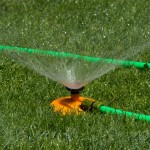
Stationary Sprinklers
Sometimes also called a cone sprinkler, these are good sprinklers to use if you have a small area to irrigate. They will operate with pretty low pressure as well, which can be a desired feature if you are running at the same time other sprinklers are utilizing water pressure.
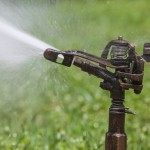
Pulsating/Impact Sprinklers
This is probably the best type of sprinkler to use whenever the area accommodates it. These rarely clog because of the large size of the outlet hole, and they deliver a nice light rain-like irrigation to areas. The best thing about impact sprinklers is the ability to set the sprinkler to water a full circle or any type of semicircle. You can also easily modify the spray distance and water droplet size with a couple adjustments. When ample water pressure is present, you can even irrigate an area as large as 100 feet in diameter. When possible, steer away from the plastic versions of these and spend a little more on their metal counterparts. Not only do they last longer, they will perform better.
Conclusion
Don’t stop watering when it looks like you’ve succeeded. Please remember that your baby lawn will not be mature for about a year. Even then, you can lose areas of mature turfgrass to drought stress. Follow the guidelines above to water at that point as well and keep that lawn live and healthy. If you need help with seeding your lawn or any other lawn care services, we’d love to talk with you about how we could help you.

